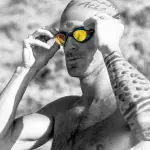
Photo: Sexton Gallery
In triathlon, speed is the name of the game. Unlike cycling and running, swimming is a bit counter-intuitive in the sense that applying more power doesn't necessarily guarantee you speed in the water. Herein lies the most uniquely difficult piece of the freestyle formula—the pull.
On average, the pull attributes up to 90 percent of total propulsion in freestyle. Breaking down the pull into three phases will help you better understand the transfer of power from overhead to the back of the stroke.
The Catch
Freestyle starts at the front of the stroke, and how you posture your arm before you begin the pull is vital. This positioning will dictate exactly how much water you're able to "hold" and your overall ability to recruit the proper muscles throughout all three phases.
For starters, let's discuss what the profile of the arm should look like at the front of the stroke. As you slice your recovering arm into the water, you want to maintain a slope, with your fingertips below your wrist and your wrist below your elbow. This kinetic chain sets you up for a high elbow catch. From a side view, the extended arm's fingertips may be seven to 10 inches below the waterline, while the elbow may be three to six inches submerged. It's most helpful to visualize these measurements as a loose gauge, as each swimmer's range of motion is different.
The transition from full arm extension to a loaded, bent arm position is the most delicate aspect of your pull. The key here is to think smooth and controlled, as opposed to a fast whipping motion at the front of the stroke. If you've ever felt that S-shaped motion at the early phases of your pull, this is indicative of your hand "slipping" through the water as it's looking for a better hold on the water.
Imagine your elbow is the hinge on a door, and focus on keeping your upper arm lifted as you smoothly lower your forearm and hand down to a vertical position below your elbow and next to your head. At this phase, the angle between your forearm and upper arm should be between 60 to 90 degrees. Practice this internal shoulder rotation motion both on land with bands and in the water during one-arm freestyle sets. The more repetition, the better, as this is the origin of your power and connection with the water.
The Pull
This is the fun stuff, the tangible reward from the effort you put into your stroke. Similar to the delicate nature of the catch, the pull requires equal precision to maximize your speed. It's now time to transition from the loading phase of the catch into the following two propulsive phases of the pull.
First, use your back. The shoulder muscles are the primary movers in the catch, but the lats (the back) are the primary movers of the pull. If you feel pain in the front head of your deltoids while pulling, this is a sign that the profile of your arm is too deep or dropped below you. If this is the case, commit to working on the catch until you're able to maintain the lift in your arm necessary for a high elbow pull.



